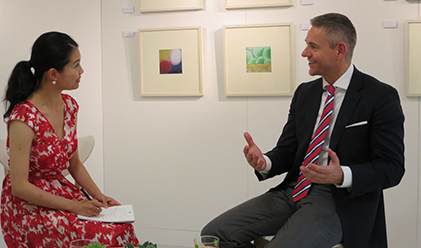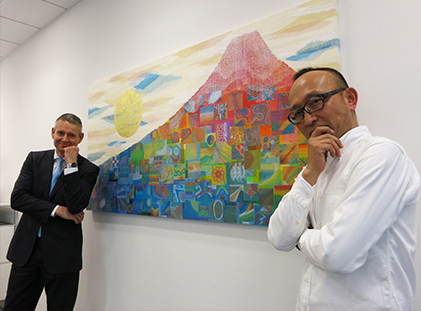Client Interview
Carsten Brunn
President & CEO, Bayer Yakuhin, Ltd
Bayer Yakuhin Japan, a pharmaceutical company, organized an EGAKU Program in which 99 employees including the CEO and executives participated. We had a chance to talk to Dr. Carsten Brunn, who assumed the presidency of Bayer Yakuhin Japan in March 2013, about his EGAKU experience and his views on art. The interview itself was 30 minutes but we learned a lot as if it were a 3-hour interview. It was so inspiring.
Interviewer:Mayuka Yamazaki (Assistant Director, Harvard Business School Japan Research Center)
Q: I heard you were interested in art already before you participated in the EGAKU Program.
A: The first thing which is important to note is that I do not have very much artistic talent (Laugh). But I always had an appreciation for art. I lived and worked in many different countries and I always found that tribal art tells you a lot about the culture there. I developed interest in tribal art when I was a student in US, West Coast. They had Native Indians ’ tribal art, which was very beautiful. Quite primitive but beautiful. Art is something which goes down to the soul of a nation.

Q: When you first heard about White Ship’s art activity, EGAKU Program, what was your impression?
A: We wanted to do something different. I wanted our top 100 managers to get away from technical and functional work and get engaged in the whole process. We looked at different things that could get people engaged, such as handicrafts, pottery, making music, drumming and sports. We got to know EGAKU as one of these options.
EGAKU was something least comfortable to me as I am not a good artist. But unlike other activities such as sports, it was what everyone could do. We took the risk and tried it out to see how people would react. I was actually nervous what kind of reactions we would get.
Q: Did you have some prior experience which made you become convinced that people would need such an occasion?
A: I have participated in different workshops and events over the years. Some were related to art. Once I participated in a very simple art-related event with my sales team in the US. We made our hands out of plaster and every time we met as a team, we brought our plaster hands and put them in circle. It was fun to begin with but it was also a ritual. It had deeper meaning: It connected us and created a sense of community.
Q: And you ended up choosing EGAKU out of various options.
A: I know I should put myself out of my comfort zone. When Kuni-san came and the session started, I remember I was thinking, “What did I get myself into?” (Laugh)

Q: How did you find the program?
It was exhausting but engaging. I really got into it. I also saw people around me and they were all quiet: it was reflecting and involving. A lot of people might have thought, “Is this man going crazy? Making us draw a picture... ” But people were engaged. And the result was stunning. The EGAKU Program struck the core of the people.
Afterwards, we did an exhibition of all 99 pieces in factories as well as offices in Osaka and Tokyo and lots of people said the pieces were beautiful. Then Kuni-san put all the pieces together in one piece of art of Mount. Fuji which is hung on the wall of my office. Whenever I have someone come to my office, they can look at it. It gives a nice connection. In addition, almost everyone who participated in the session put their own art in their office.
Q: What surprised you most?
I was surprised to see people’s reaction. Nobody complained and we got really high ratings in the feedback survey. People really enjoyed it and some were shocked to know they could actually draw. It was stronger reaction than I originally expected.
But actually, my biggest reaction came from the Mount Fuji collage which Kuni-san put together. The art is powerful with the emotions of 99 people. I get an emotional reaction every time I look at it. It is not only visually beautiful but meaningful and connected as the top 100 people in the company put how they feel about working at Bayer in there.
Q: Have you seen changes in people’s attitude?
A: I think it is hard to say. For me, this was one piece of puzzle in a journey to try to change the company’s culture, a journey to make the culture more self-reflected and people-first. It was one intervention and I did not want to make it just all about art. It was about change, sustainable change.

But at the same time it was an important intervention. Art is something very sustainable. You create something you can keep. It was one intervention but a lasting one. It has the right energy, I would say, somewhat self-reflected but still expressive. And you can share it with other people. One thing about EGAKU is to create art and the other thing is to let other people look at and talk about your own art.
Q: You can find different dimensions of people by looking at pieces of art they created.
A: The 99 pieces were quite different in color, techniques used - there was so much diversity. I initially thought everyone’s work might be the same but it was not true, surprisingly. People expressed themselves quite differently and that speaks for the diversity of the group.
Q: That realization made you become more hopeful about the company?
A: Absolutely yes. It gives me confidence. They were mostly middle-aged Japanese men but there was much diversity there. Art resonates with people, emotionally.
I was a speaker at a pharmaceutical industry association yesterday. One of the three topics I talked about was how to engage the hearts and minds of people and how to link them to our corporate mission. And I picked the EGAKU as an example and showed them the video. After the talk, many people came to me and said, “It was quite emotional. How can we do this?”
Q: Do you think you received such reaction as they are in the healthcare industry? I may be wrong but people in the healthcare industry may tend to think more about how they can better serve the society due to the nature of the business.
Yeah...Yes and no. If you look at the industry, the environments surrounding the industry have been changing. It is time to reflect. I once looked at the mission statements of all the big healthcare companies. They are all very similar - all about giving back to the society, for patients, being ethical etc. But are we operating our business based on the mission? You have to re-identify yourself with the corporate mission.

And we tried to do that with EGAKU Program. Bayer’s mission is “Science for a Better Life” but what does it really mean to you? How do you make sure people have the right motivation? In the end, it is individuals who make mistakes that lead into the press. We did EGAKU to engage individuals with the company’s mission and I think, with all these scandals in the healthcare industry, it has recently become even more relevant. You ask yourself what your purpose as an organization is, whether you can really believe in it.
Q: I once participated in an EGAKU Program with human right activists and the theme was “What makes us human”. I understood about human rights in my head but not in my heart. But through drawing, I suddenly realized I was just so blessed and enjoyed human rights like air, taking it for granted. That kind of realization is different from understanding something intellectually.
A: Yes, I think that is exactly what EGAKU Program does. For many people, and I have to be honest here, for myself as well, it was the first time that I really thought about what Bayer’s mission statement means “to me”. I was thinking a lot about how I should communicate it as a president. But how do I, as an individual, feel about it? Which made me really reflect about the purpose of my life and whether it matches the corporate mission. It was quite interesting to discover.
Q: Have you made any changes in the company’s strategy based on the reflection you had on the mission statement?
 A: I am not sure about that but I am a lot more confident talking about the mission statement. When I talk about our mission statement now, people feel that I truly believe in this, as I thought about the mission intellectually and emotionally. It is always easier to communicate something when you have an emotional attachment to it, not just a rational one. In the end, people are not rational but emotional.
A: I am not sure about that but I am a lot more confident talking about the mission statement. When I talk about our mission statement now, people feel that I truly believe in this, as I thought about the mission intellectually and emotionally. It is always easier to communicate something when you have an emotional attachment to it, not just a rational one. In the end, people are not rational but emotional.
Q: How do you think the relationship between art and business will evolve?
A: I think traditionally there has been a strong relationship between business and art. Business leaders are often times art collectors. I know lots of companies which display art, buy art or have a big collection of art. There have been also attempts to try to use art for branding purposes. The connection has been always there but I think at the same time there should be some distance. I do not want art to be too commercial. Artists need freedom to create and to be creative.
Q: What do you think about the 99 “artists” who participated in EGAKU? They are business people working at the company but at the same time they can create such beautiful pieces of art.
A: Yes, art and business are not mutually exclusive. That is true.
Q: Are you thinking about coming back as an individual participant?
A: Yeah, I might do that. When I did the second session here at 92art Studio), my piece was completely different from the first one, which was also very interesting. We find something in ourselves which we did not know.
Interview held in July 2014
Mayuka Yamazaki (Assistant Director, Harvard Business School Japan Research Center)